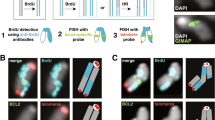Abstract
Sister chromatid exchange (SCE) is the phenomenon of partial DNA exchange during DNA replication. SCE detection has been developed through eliciting DNA’s semiconservative replicative nature. Thymidine analogues such as 5′-bromodeoxyuridine (BrdU) and ethynyldeoxyuridine (EdU) are incorporated into the newly synthesized DNA for two cell cycles. The addition of Colcemid to the culture blocks and synchronizes cells at mitosis, and conventional cytogenetic preparations are made. Differential staining methods with Hoechst dye and Giemsa (Fluorescence Plus Giemsa staining), antibody detection against BrdU, or highly specific Click reaction to EdU, allow the newly synthesized DNA within a chromatid to be recognized. SCEs represent a point of DNA template exchange during DNA synthesis, visualized by differential chromatid staining or harlequin chromosomes. We will introduce three basic protocols in this chapter including non-fluorescence and fluorescence methods for SCE microscopic analysis. SCE is a very sensitive marker of genotoxic stress during replication.
Access this chapter
Tax calculation will be finalised at checkout
Purchases are for personal use only
Similar content being viewed by others
References
Taylor JH, Woods PS, Hughes WL (1957) The organization and duplication of chromosomes as revealed by autoradiographic studies using tritium-labeled thymidinee. Proc Natl Acad Sci U S A 43:122–128
Gebhart E (1981) Sister chromatid exchange (SCE) and structural chromosome aberration in mutagenicity testing. Hum Genet 58:235–254
Nagasawa H, Little JB (1992) Induction of sister chromatid exchanges by extremely low doses of alpha-particles. Cancer Res 52:6394–6396
Ellis NA, Proytcheva M, Sanz MM, Ye TZ, German J (1999) Transfection of BLM into cultured bloom syndrome cells reduces the sister-chromatid exchange rate toward normal. Am J Hum Genet 65:1368–1374
Wilson DM III, Thompson LH (2007) Molecular mechanisms of sister-chromatid exchange. MutatRes 616:11–23
Conrad S, Kunzel J, Lobrich M (2011) Sister chromatid exchanges occur in G2-irradiated cells. Cell Cycle 10:222–228
Gutierrez C, Gonzalez-Gil G, Hernandez P (1983) Analysis of baseline and BrdU-dependent SCEs at different BrdU concentrations. Exp Cell Res 149:461–469
Heartlein MW, O’Neill JP, Preston RJ (1983) SCE induction is proportional to substitution in DNA for thymidine by CldU and BrdU. Mutat Res 107:103–109
Suzuki H, Yosida TH (1983) Frequency of sister-chromatid exchanges depending on the amount of 5-bromodeoxyuridine incorporated into parental DNA. Mutat Res 111:277–282
Hazen MJ, Villanueva A, Juarranz A, Canete M, Stockert JC (1985) Photosensitizing dyes and fluorochromes as substitutes for 33258 Hoechst in the fluorescence-plus-Giemsa (FPG) chromosome technique. Histochemistry 83:241–244
Nagasawa H, Little JB (1979) Effect of tumor promoters, protease inhibitors, and repair processes on X-ray-induced sister chromatid exchanges in mouse cells. Proc Natl Acad Sci U S A 76:1943–1947
Su C, Allum AJ, Aizawa Y, Kato TA (2016) Novel glyceryl glucoside is a low toxic alternative for cryopreservation agent. Biochem Biophys Res Commun 476:359–364
Cartwright IM, Kato TA (2015) Role of various DNA repair pathways in chromosomal inversion formation in CHO mutants. Int J Radiat Biol 91:925–933
Nagasawa H, Fornace D, Little JB (1983) Induction of sister-chromatid exchanges by DNA-damaging agents and 12-O-tetradecanoyl-phorbol-13-acetate (TPA) in synchronous Chinese hamster ovary (CHO) cells. Mutat Res 107:315–327
Author information
Authors and Affiliations
Corresponding author
Editor information
Editors and Affiliations
Rights and permissions
Copyright information
© 2019 Springer Science+Business Media, LLC, part of Springer Nature
About this protocol
Cite this protocol
Sunada, S., Haskins, J.S., Kato, T.A. (2019). Sister Chromatid Exchange as a Genotoxic Stress Marker. In: Kato, T., Wilson, P. (eds) Radiation Cytogenetics. Methods in Molecular Biology, vol 1984. Humana, New York, NY. https://doi.org/10.1007/978-1-4939-9432-8_7
Download citation
DOI: https://doi.org/10.1007/978-1-4939-9432-8_7
Published:
Publisher Name: Humana, New York, NY
Print ISBN: 978-1-4939-9430-4
Online ISBN: 978-1-4939-9432-8
eBook Packages: Springer Protocols




